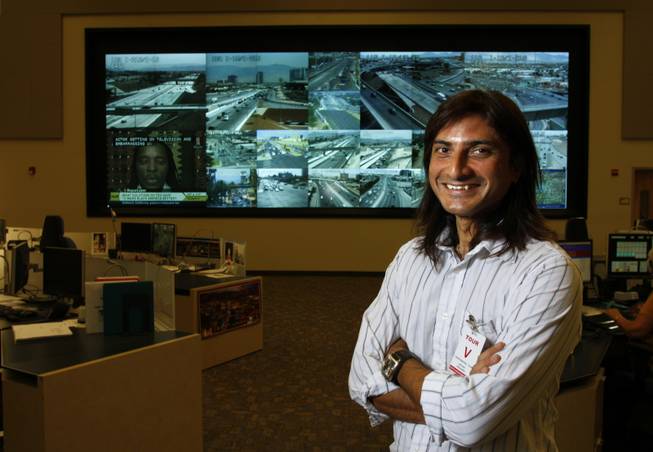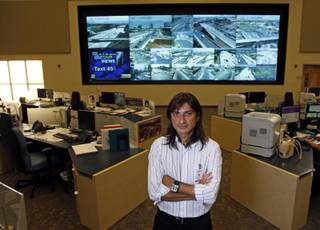
Pushkin Kachroo, a UNLV professor in electrical and computer engineering, poses at the Regional Transportation Commission’s Freeway and Arterial System Transportation (FAST) center. Kachroo and his students is working with colleagues, students and government agencies on ways of tracking traffic electronically and getting information to drivers to help them avoid accidents and other disruptions. He’s also drawing top talent in his field to UNLV.
Sunday, July 26, 2009 | 2 a.m.
When you notice that car crashes and road construction aren’t tying up Las Vegas Valley traffic for as long as they used to, remember this name: Pushkin Kachroo.
The co-director of UNLV’s Transportation Research Center is considered something of a genius by traffic engineers. The university lucked out when it got him. He came to Las Vegas two years ago from Virginia Tech only because his wife landed a job as a marketing professor at UNLV.
His resume includes degrees, including two doctorates, from top U.S. and Indian universities. He has published eight books and armloads of academic papers.
The stack of academic accolades is impressive, but he is also making a major difference where the rubber, literally, meets the road, experts say.
He is using his deep and varied expertise in robotics, electrical engineering and mathematics to improve traffic flow throughout the valley.
“Transportation has changed dramatically in the last 20 years,” Kachroo explains from his office in UNLV’s new engineering building. “It used to be about planning and infrastructure — roads, freeways, bridges. Now it’s about sensors and lights and active traffic control.”
Kachroo researches feedback control — essentially action, sensing and reaction. He has applied his research to everything from an electronic sense and response feature in cars to his latest work on traffic patterns across a major metropolitan area.
Here’s his type of scenario: If there’s an accident at Flamingo and Paradise roads at 5 p.m. on a normal Tuesday, what happens? How does it affect traffic not just at that intersection, but near the Strip, the airport, the Las Vegas Beltway, Eastern Avenue and Interstate 15? How long does that disruption last?
And what’s the best reaction to make the system work efficiently again? Do you program signals at other intersections and freeway on-ramps to handle an increase in traffic and speed people away from the now-impaired intersection? Do you reroute traffic? Send e-mail and text messages telling commuters to avoid the intersection? Put a message on freeway signs?
This is the future of transportation management.
At UNLV, Kachroo has helped develop an entirely new discipline in engineering: Transportronics, blending transportation research with electrical engineering. And he has attracted talented students and researchers from top international universities — Cal, Harvard, MIT, the Indian Institute of Technology. One of his students, Lillian Ratliff, just won a prestigious National Science Foundation graduate fellowship.
His team, most of whom have been recruited by universities around the globe, are here spending hours poring over sheets of numbers and applying mathematical formulas to how traffic was affected that time a taxi cut off a tourist in a rental car and he swerved into a light pole on Swenson Street.
Kachroo, his Transportation Research Center co-director Ken Peck, and the rest of their team are trying to build the center into a world leader.
They’re churning out thesis and dissertation quality research papers monthly. And administrators are trying to expand the center’s academic offerings by establishing a joint Ph.D. program with the business college so transportation management and traffic engineering students can get more expertise in policy and finance, something necessary for government projects.
Kachroo thinks all of that can be achieved within five years, which would translate into more predictable commutes for all of us for years to come.
The Transportation Research Center team works with the staff of FAST — the apropos acronym for Freeway and Arterial System of Transportation. These are the people and computers that can cut your commute in half or keep you out of a traffic jam on I-15.
At its heart is a traffic control command center that looks like something in an Apollo mission. The front of the room is dominated by a two-story screen showing several live video feeds from a few of the more than 100 traffic cameras on highways and surface streets across the valley.
In this room, traffic technicians and Nevada Highway Patrol dispatchers work side by side to respond to emergencies and manage traffic around any incident that creates congestion.
One example of the benefit of the FAST-UNLV teamwork is the traffic light synchronization along Charleston Boulevard, which makes that street a quicker weekday morning route from Summerlin into town than Summerlin Parkway.
In many if not most cities, when engineers start developing a freeway or synchronize traffic lights, they base their plans on statistics that are often sporadic, short term and frequently outdated, says Brian Hoeft, assistant director of FAST.
But because Las Vegas is a relatively young city, more of its streets are wired with technology whose kinks have been worked out elsewhere.
Kachroo and his UNLV team have access to a mountain of real-time data from FAST — average speed, car volume, frequency and time of accidents — all collected, intersection by intersection, by a network of sensors. The result is a coordinated traffic management system based on real-world conditions.
That data is funneled to the Transportation Research Center — students and faculty with backgrounds in electrical, traffic and mechanical engineering, robotics and mathematics — who synthesize and analyze the data in minute detail to get information that can be used in traffic planning and management.
As traffic builds in the northbound lanes of I-15, a technician at FAST types out a message to drivers — travel time to Flamingo, 5 minutes; to Charleston, 10 minutes; and so on.
The message pops up on electronic traffic signs all along the corridor.
A similar warning pops up in the form of a text message on the cell phone of UNLV Ph.D. candidate Neveen Shlayan.
She’s sitting in Kachroo’s office, and they’re discussing how to apply a formula normally used to detect bugs in software to predict the traffic repercussions of accidents at specific intersections at different times of day.
Her analysis will soon be incorporated into an academic paper and, she hopes, be presented at a conference or two. It could also change the way emergency responders and traffic technicians at FAST deal with accidents at those intersections.
“Everyone is learning in this era of instantaneous information,” Hoeft said. “We love that Pushkin and his team are here. We can get all the data in the world, but we don’t always have the time to analyze it. They spend all their time analyzing and we can concentrate on implementing what we’ve learned.”
Someday, as technology progresses, the system will communicate directly with in-car and cell phone GPS systems to help drivers avoid high congestion areas by changing their routes based on real-time information instead of guesses.
And if he needs to, Kachroo will come up with a way to keep motorists from checking their text messages while driving, too.


Join the Discussion:
Check this out for a full explanation of our conversion to the LiveFyre commenting system and instructions on how to sign up for an account.
Full comments policy